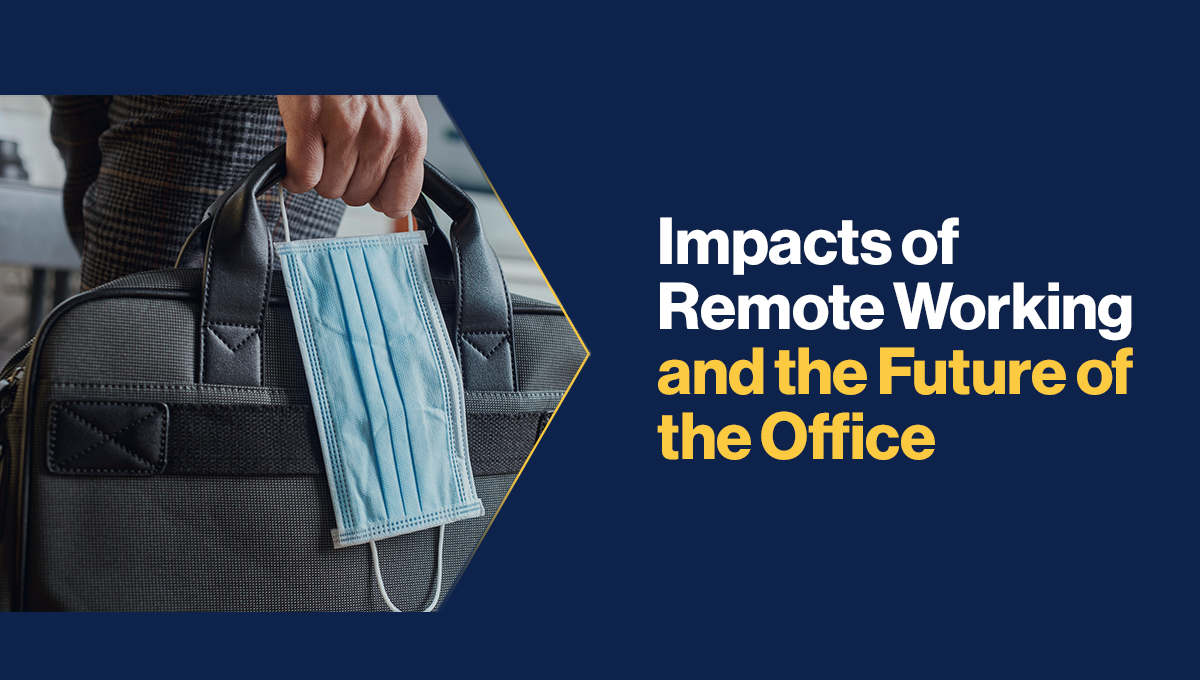Impacts of remote working and the future of the office

The impact of lockdown and remote working and how it has impacted businesses and their staff coupled with how, when or if offices will re-open fully are two of the biggest global industry discussion points at present.
We sat down (virtually) with Pallavee Patel (Risk & Business Resilience Lead, National Grid Metering, (based in the UK), Daman Dev Sood, BC & Resilience Consultant (based in India and the Middle East) and Dale Condon, Governance (Digital and Services) Manager (based in Australia) to discuss their thoughts on the subject …
Initial impacts of lockdown
- The longevity of the crisis caught many organizations by surprise.
- Issues arose in many countries from the lack of a centralized government response.
- Confusion arose in the early stages whilst organizations were still finding their way.
Offices being closed due to flooding and manufacturing plants shut down because of power outages are fairly frequent occurrences, but the modern world had never experienced a ‘global lockdown’ to the extent of the one in 2020. And this was the problem.
“I believe no one in the world was prepared for it, even if you have 10 – 25 years in BCM, you have studied the ISO 22301 or NCEMA 7000 standards in the UAE, no one was prepared for what happened,” noted Sood.
It was a new experience for all and with that brought confusion, ‘No one knew how long lockdown was going to last so there was a lot of anxiety from folk about returning to the office,” said Patel, “there were a lot of people that were averse to working remotely because they were predominantly always office based, so it was a real challenge for them in trying to understand a new way of working.”
One of the issues experienced in many countries was the lack of a centralized response from national government. Condon commented that, ”In Australia they started a national cabinet for the pandemic, and this was probably one of the best decisions they made – it was the Prime Minister and all the state leaders -it was amazing the unity across government for the crisis - with all politics put aside - and it really served us well.’ The problems in Australia came later when politics did get involved, and each state started triggering their own lockdowns and border closures based on different criteria.
Across businesses and geographies, the reaction of staff was the same though. Some immediately took to the newfound freedom of remote working and the benefits this brought whilst others missed their daily routine, social interaction, and the office environment.
Managing Remote Working
Communication
- The need for regular two-way communication during a crisis is of paramount importance, and the pandemic has been no exception.
- There is an expectation from senior management to show leadership and ensure channels of communication remain open.
- Technology has been a gamechanger for communication during the pandemic, but it has unique social challenges attached.
Communication. Communication. Communication. This was the message repeated by all three interviewees.
As with any crisis, communication is the most important element to get right, and that communication needs to be regular and consistent. This was crucial throughout the pandemic with most organizations having staff working remotely.
There was an expectation on senior management to show leadership and ensure staff were kept up to date. This was not only to provide updates on plans for the return to the office, but also on business performance -with many worried about the long-term outlook for their organization. Those that failed to provide these regular updates noted a profound negative effect on staff mental health and wellbeing, something discussed at length in the 2021 BCI Horizon Scan Report (Link).
Zoom and Teams became organizations’ best friend in enabling staff to communicate and continue with face-to-face interaction. “At first staff were reluctant to put on their videos, but in a short while those fears went away, and people got used to putting on their cameras whilst in their pyjamas with kids running around” commented Patel. However, not everyone was of the same opinion. Sood highlighted that in some cultures people are reluctant to put their cameras on because they do not want to show their homes, animals, or children in the background; one of many cultural differences highlighted throughout the interviews.
The importance of two-way communication also came across clear. This was an unprecedented situation and the need to take staff opinions and welfare into account was paramount, as Patel pointed out “it was a balancing act of what our staff needed and what our customers wanted”. All three agreed that staff should be consulted about the return to the office, whenever that was possible.
Technology & Security
- Remote working, whilst very effective for most, comes with security challenges.
- For international organizations, the reliability of technology infrastructure in some countries has to be accounted for.
- The physical remote working environment can result in privacy issues.
IT and security were other major talking points. Sood was quite clear in his opinion that, “information security and physical security at home does not match what is available in an office” and that remote working should not be considered a long-term option for all organizations because of this reason. Condon and Patel were a little more positive on this matter. Condon pointed out that cyber security awareness & training had been a major priority for her organization over the last 12 months and felt staff had never been so aware, whilst Patel described some of the solutions in place at National Grid Metering that had helped in this area, such as use of a VPN, Multi-factor Authentication, and a Tech Bar for IT support.
Patel also added that it was not just IT Security that was now more of an issue, but also physical security. She noted how her organization, along with many others, were sending out regular reminders about the dangers of printing off secure information and its disposal. Sood also commented on how many staff felt it impossible to have ”private work conversations” without other members of the family or close neighbours overhearing which could result in privacy issues.
Sood also underlined that another challenge in this area was national infrastructure and how it varied from country to country – and even within a country. Many of us take good quality internet for granted, but this is not the case for all. In some countries in Africa, for example, only 3% of the population have access to the internet (source: ourworldindata.org). Even in European countries, like France or Spain, 20% of the population is still without internet. This just adds complexity to the remote working puzzle.
This meant that BC & resilience professionals, as well as top-management, needed to be aware and deal with employees’ technical challenges, particularly if staff were based in geographies or different countries.
People
- Remote working has reduced sickness levels but brought mental health and wellbeing challenges.
- Measuring work based on outcome rather than time can be more effective in a remote working environment.
- The problem of overwork and the creation of a work/life inbalance as a result of homeworking has already pushed some staff to the limit.
- The physical environment (e.g complying to workstation laws, a lack of space in the home environment) will have to be addressed if remote working continues in the mid- to long-term.
How companies look after and manage their people were a primary concern noted by all.
Condon argues that one of the initial fears and challenges of managers was how they were “going to measure staff performance and how will [they] know employees are working.” She anticipated a “a big shift towards measuring outcomes and not hours.” Condon also added that this would have been replicated across many organizations and, without that physical presence, managers were left with little alternative but to trust their staff in ways they had not before.
A positive aspect noted by Patel was that “sickness levels had reduced massively over the last year” with staff being able to take a few hours to recover from a headache rather than calling in sick for the whole day. Furthermore, the lack of human contact meant less flu and other sickness, as well as less requests for time off.
With staff having more freedom, many have found that this new way of working increased productivity. However, Sood would strongly disagree with this and argued: “It is reported by large corporates that productivity has gone up whilst people are working from home, but I have serious doubts about this. Productivity hasn’t gone up – output has gone up because instead of working 8 hours people are now working 10, 11,12 hours”. This sentiment was echoed by Patel who highlighted fatigue as a new threat for organizations to be aware of, noting that “People are losing track of time and working later” and some are wanting “to prove themselves more by working harder and later.”
All of this leads to what has become a major talking point of the last 12 months – mental health.
Condon described that “there have been a lot of mental health challenges and that there will be long term repercussions for this” whilst Sood added, “many staff have also directly or indirectly been impacted financially through salary cuts, salary delays, furlough and redundancies” all of which would influence people’s state of mind. Sood took it one step further and suggested there had been no research on the emotional impact to staff and that some form of emotional impact analysis should be carried out by organizations, governments, and research agencies into the effects lockdown and remote working have had on people’s mental health.
Sood continued that many were now suffering from a work/life IN-balance (contrary to the general conception that this has improved). He strongly believes that having an office at home was ‘intruding’ on people’s privacy and family dynamics, causing more stress and family disputes. He noted it was “hard for children to understand that when you are working from home, you need to work, and telling them to go away or be quiet” and questioned the “impression and damage it was leaving on them?”. Sood also notes, this may be less of a problem in the UAE where there is more space and some even have home offices but in India, where there is less space and large families live together, it can be a real issue.
The difficulties associated with remote working add to those already felt in ‘life in lockdown’, not being able to see relatives, going shopping, or doing the things one would normally do to relax away from work have all affected peoples’ mental wellbeing.
Another consideration was how remote working impacted young workers and new employees. Newcomers to the office environment usually learn from those around them – how to answer the phone, deal with challenging situations, understand mannerisms and other kinds of behaviours; they learn from role models. How can this be replicated via video? For new employees, how can you build relationships with your colleagues over Teams? When will you have those water cooler or kitchen conversations to really get to know someone? These are all things that need to be considered if remote working continues.
Other questions related to this topic include how remote working impacts people physically? Do staff have the right equipment at home to carry out their role safely? Condon commented that in her organization ” all staff have access to ergonomic assessment, resulting in desks, chairs and monitors provided if needed”. However, how many others can say the same? Working from home twice a week is one thing, but many employees have been working remotely for 12 months, and without the right set up this could lead to strains and posture issues. Google tackled this issue by offering all employees $1,000 for a work from home allowance to purchase equipment, but unfortunately not all companies can afford to do this.
One final line of questioning raised by Sood was, ”Is work from home even legal? If I work from home are all the rules, regulations, and policies of the office applicable at home? Many companies have the concept of ‘Death in Service’ where if someone dies in the office there is compensation available to his/her family. If that person now dies whilst working from home, will their family still receive the compensation?” This is a valid point, and one which leads to further questions: have organizations updated their policies and regulations to reflect this new working arrangement? Have they ignored in the short term, assuming staff will return shortly? Have staff contracts been updated? These are all questions companies need to consider.
Returning to the office
- The return to the office needs to be managed carefully and staff kept fully informed of the process.
- Whilst the hybrid (home/office) model may work for some organizations, the hot desking approach could lead to greater infection risk.
Condon and Patel both stated that their offices had remained open during the prolonged lockdown period. This was for staff that could not work remotely due to their roles and/or due to an unsuitable home environment. This is a route many businesses have taken.
Condon described that in her organization they had, “basically halved occupancy in all offices - chairs & desks removed, hand sanitizer everywhere, and extra cleaning booked” and that they had, “COVID safety plans developed for all locations”. Patel went on to list several measures that were already in place at her company including:
- Changed office layout and the introduction of one-way systems
- Separate lifts & stairs for up/down
- Bring-your-own plates/cups for food & drink
- A log of who was in the building
- Capacity limit on the number of people allowed in the building
- Space between desks
Both agreed that communication had been vital for those attending the office during lockdown and will be equally important when the office fully re-opens. It is essential that staff understand that they are walking into a very different environment to the pre-pandemic one. Patel argued that the priority is to “Make sure staff aren’t under any illusion that when they go to the office there won’t be any social gatherings. It might seem like really basic stuff, but what we are trying to do is make sure we hone in on the fact that we have to look after our people and protect our staff and their wellbeing,’ So, it may be a while before the kitchen chat resumes.
When it came to the long-term cost of returning to the office there were mixed views. Some organizations might have the option to reduce the amount of physical infrastructure they need if more people work remotely and adopt some form of hybrid model as many predict. However, other organizations may need more space due to the need for social distancing within the office. Condon commented that “many companies will definitely downsize office space, particularly in the expensive CBD’s – which could be an opportunity for companies like Regus to say ‘’why lease when you can just book space when needed’”. There were also differing opinions on whether desk booking systems would be brought in in some organizations - hot desking would certainly help with reducing the amount of space required, but equally the introduction of shared workstations could increase the risk of transmission.
When will offices re-open
- The return to the office will largely depend on country-specific vaccination programmes.
- Most companies intend not to rush the return back.
There were differing opinions about when staff would return to the office, but there was a unified view that the return would not be rushed. Condon pointed out that “the Public Health order was rescinded on 14th December 2020. They expected this mad rush back to the office and everyone was worried about the limited occupancy – but then Christmas came. So, it wasn’t until after the holiday break and when people started to return, after Australia Day. But even now our occupancy rate is between 12 – 15%, so it is actually still a slow process.” She further added, “We are at the stage where we are allowing people to go back in, some are requesting they go back in, but not many are mandating that staff go back in yet” and this was similar across both public and private sectors.
In the UK, Patel noted that “When the announcements were made by UK Government, we put a loose date around summertime, but what we are also doing is not putting pressure on people. Staff have become used to working from home and now the challenge is to ease them back in gradually.” Sood added that he thought it would be by the end of 2021 before most would be back in the office in India.
What was agreed amongst the three was that the time when offices started to fill up again would be dependent on the speed of vaccination rollout in that country, Sood commented “I do not see an urgency as vaccination is at low level in India, the duration of its effectiveness has not been established yet, and new variants of viruses have been appearing”. Patel added to this theory by stating it will depend on what happens with the virus - organizations and governments will be concerned about going back to the office too quickly. And all agreed staff should be consulted on the matter.
Tips for returning to the office
All three were asked what their advice would be for returning staff safely to the office:
- Make sure your people are at the heart of what you do and let them have a say in how they work.
- Bring staff back in stages
- Look at the positive changes the pandemic has brought to the working environment and seek to incorporate them going forward.
- Consider the need to increase social distancing for staff.
- Expect extra costs for sanitisation.
- Ask employees a) if they want to come back and b) what can the company do to make them feel safe.
- Consider additional measures for staff mental health and wellbeing such as more counsellors on hand for staff.
- Ensure very clear messaging about what the rules are and make sure people do not become complacent about them.
- Make sure there is alignment between management and staff.
- Be prepared for future snap lockdowns.
What is clear from the three interviews is that there is no definitive plan for organizations to follow. When and how organizations return staff to the office will be an individual choice based on a plethora of circumstances which will be largely steered by the vaccination programme in each country. After that, decisions will come down to individual organizational choices and preferences.
Thanks to Daman, Dale, and Pallavee for their contributions.








































